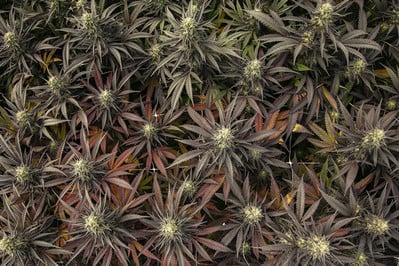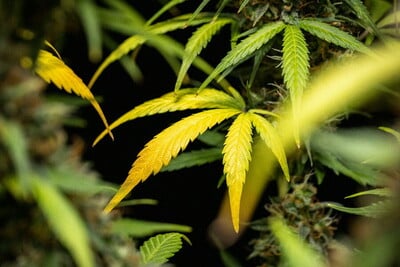.

Albino Weed: The Stuff Of Legend Or Scientific Fact?
Albino weed is indeed a possibility. Despite scepticism of the phenomenon, both environmental and genetic factors play a role in the occurrence of the condition.
Every once in awhile whilst browsing the internet for the finest cannabis porn available, one might come across weed that isn’t in any way green. Some rare findings might involve stumbling across beautiful shots of cannabis that feature strong shades of purple and even red. However, the rarest sighting of them all has to be pure white weed.
This phenomenon is absolutely beautiful; the sight of alabaster, glistening buds erupting with streaks of red calyxesis a sight to behold. But what is at the root cause of such an outcome?
Contents:
Albinism in Cannabis Plants
No, it’s not just a Photoshop job. Pure white cannabis plants do exist and emerge from time to time. However, this isn’t exactly the result of a successful and accurate breeding project, and it certainly isn’t intentional (most of the time). Pure, bright white cannabis plants are actually the result of albinism. Much like in animals, albinism can also occur in plants and is the result of a lack of pigmentation.
The pigment that usually makes cannabis leaves and flowers green is known as chlorophyll. Chlorophyll is an absolutely vital component in the life of plants as it plays a major role in the process of photosynthesis.
Photosynthesis is the process of converting light into sugars in order for plants to survive and thrive. The chlorophyll present within cannabis leaves is used to absorb the light in the first place.
So, although the white appearance of albino cannabis plants might look spectacular and impressive, it’s actually a massive genetic disadvantage. The pure white aesthetic is a sign of a huge lack of chlorophyll, meaning that albino plants are almost incapable of carrying out the process of photosynthesis and therefore cannot generate the energy they need in order to survive and reproduce.

Busting Myths
Some cannabis enthusiasts state the argument that albino cannabis plants don’t actually exist, and that all photographic evidence of this phenomenon is either false, or depicts other conditions instead of albinism.
This argument is in some ways reasonable, after all, how can a plant that is unable to carry out photosynthesis going to survive long enough to reach a respectable size?
Some of the sceptics out there believe that cannabis albinism isn’t albinism at all, and is simply a case of chlorosis. Chlorosis is a condition that can set-in due to a lack of nutrients in the soil. However, true albinism is a condition in which very little chlorophyll is produced from the get-go.
It is highly unlikely for a fully-albino cannabis plant to reach maturity for obvious reasons. However, partial albino plants, known as variegated plants, feature only slight albinism. These only have specific patches of white leaves and buds that are void of the green pigment. The rest of the plant is indeed green, loaded with chlorophyll, and able to photosynthesise.

The Causes of Albinism in Cannabis
Albinism can have numerous causes. Both environmental and genetic factors may play a role. Environmental conditions such as growing media, light, and temperature can all contribute to plant albinism.
However, genetic factors are reported to play a much more fundamental role in the rare condition. Albinism has been shown to be a recessive trait, with the pigment defect probably caused by incompatibilities between nuclear and chloroplast genomes.
Hybridisation is also believed to be a major cause of albinism. Cannabis growers and breeders sometimes backcross strains in order to tease out desired recessive traits that specific strains posses. In doing so, this process may cause albino traits to express themselves.


False Albinism
Just because a cannabis plant starts to display a white aesthetic does not mean it is expressing albino traits. For example, plants can start to turn shades of white due to bleaching caused by lighting.
Sometimes, when the top buds and leaves of a tall cannabis plant get too close to the light source due to explosive growth, the intensity of the light may become too much. This occurrence can end up bleaching, which gives the overexposed parts of the plant a white appearance.
Is Albinism to Be Sought Out or Avoided?
Albinism is ultimately a genetic fault within a cannabis plant. If you are a grower or breeder that is seeking to maximise flower output, growth speed, and strain potency, albino plants will only get in the way of productivity and progress.
However, growers who have time on their hands may want to pursue albino cannabis plants out of experimental curiosity. These plants won’t do you any favours in terms of a potent and large stash, but they will certainly contribute toward some fantastic cannabis photography.








































